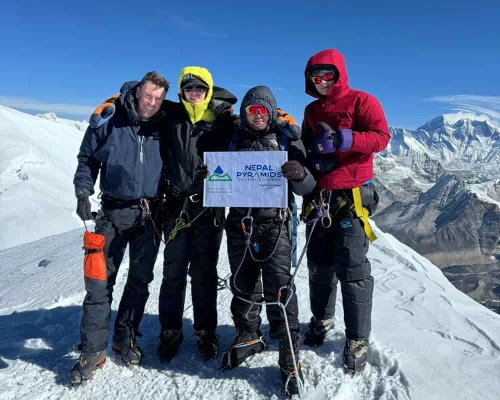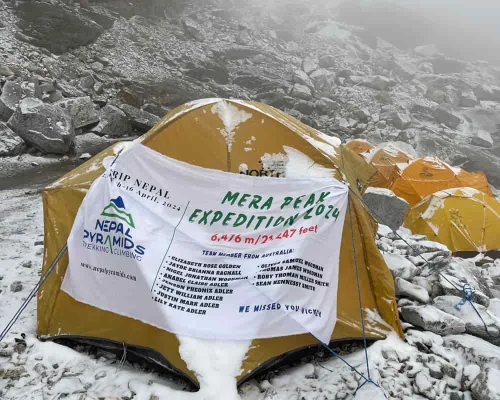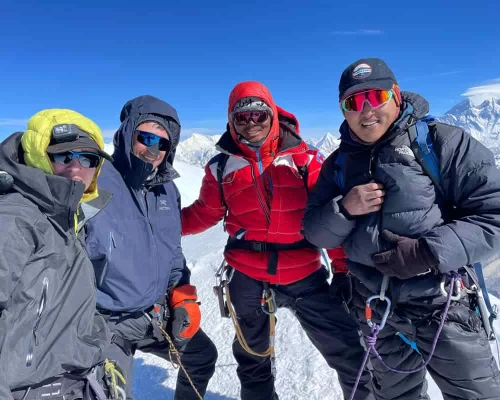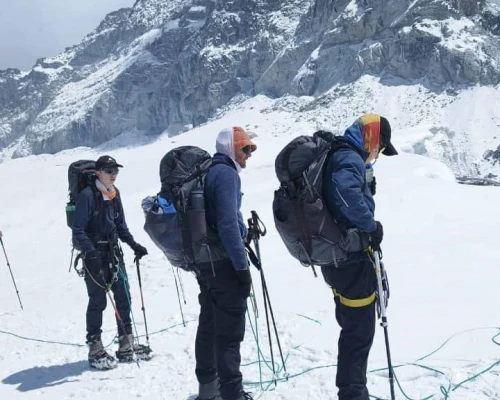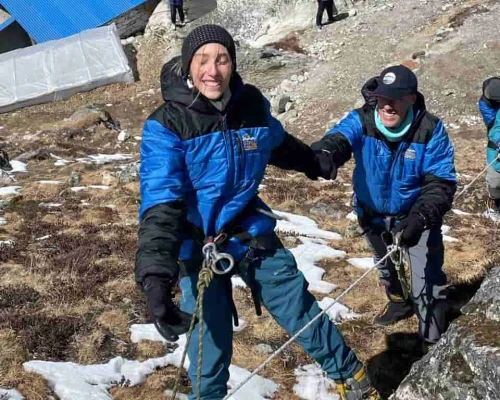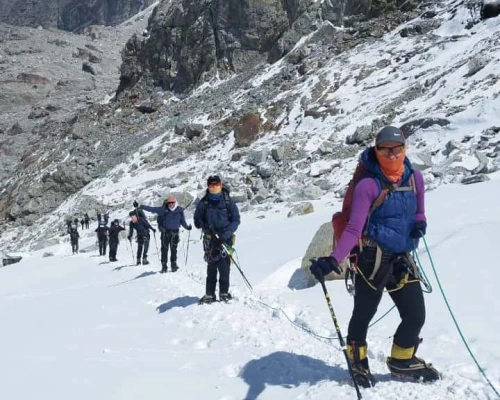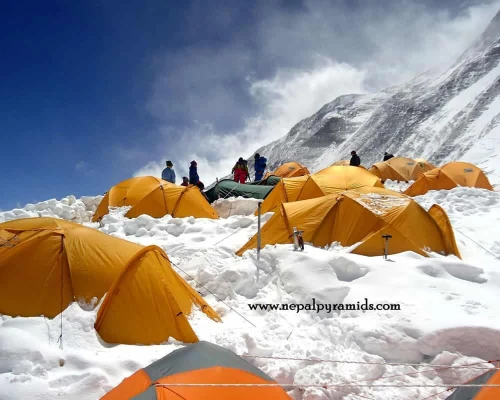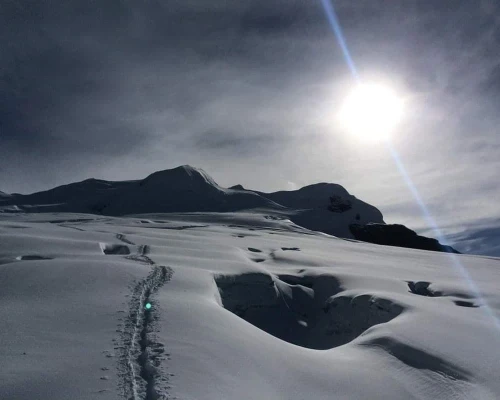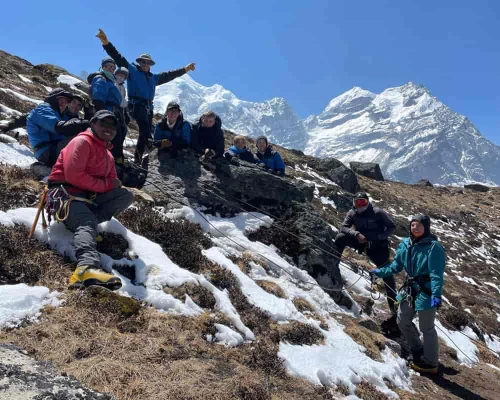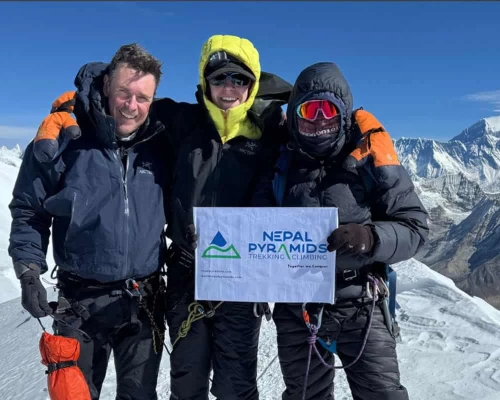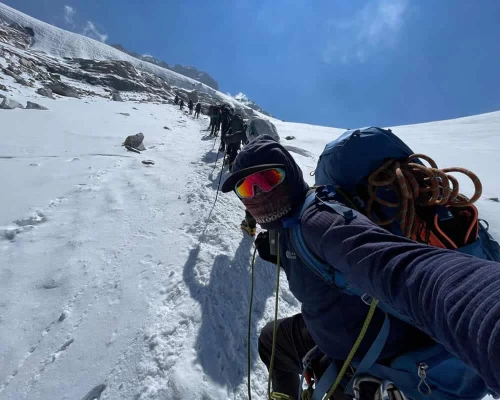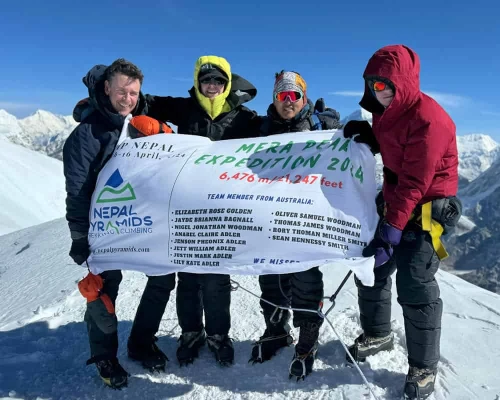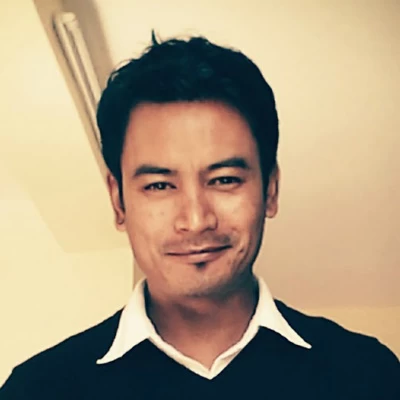Mera Peak Climbing Trip Overview:
MERA PEAK, which stands at a height of 6,476 meters, Mera Peak is considered the highest trekking peak in Nepal. This 20-day Mera Peak Climbing is indeed an ideal pick for both beginners and climbers to experience the thrill of Peak climbing in Nepal. Mera Peak is situated away from the commercial Everest region in the pristine Makalu-Barun area above the Hinku Valley.
The Makalu-Barun area is one of the most breathtaking protected regions in northeastern Nepal, and it is home to the majestic Mt. Makalu, the world's 5th-highest mountain. It was established as a national park in 1992 and offers topographical diversity, ranging from subtropical forests to alpine zones and glaciers. The journey through Makalu Barun is indeed a cultural expedition through the landscapes inhabited by the Indigenous Sherpa and Rai communities.
Among the 27 Trekking Peaks in Nepal, the most sought-after peaks are Mera Peak, Island Peak, Lobuche Peak, and Chulu Far East Peak. However, among the highly searched 6,000-meter peaks in Nepal, Mera Peak wins the title. Trekkers and Climbers say that the Mera Peak Expedition is indeed something out of the ordinary, something more special. Mera Peak Climbing offers a beautiful blend of both trekking and climbing experiences.
The history of early exploration of Mera Peak is fascinating. The first recorded Mera Peak Expedition was in 1953, led by Jimmy Roberts, a renowned British mountaineer and explorer. Colonel Jimmy Roberts is very popularly known as the father of Trekking in Nepal. He explored every corner of this country, and in 1965, he introduced trekking in Nepal.
On May 20, 1953, Col. Jimmy Roberts and Sen Tenzing first summited Mera Peak, and in the same year, Tenzing Norgay and Edmund Hillary made their historic Everest summit. This Mera Peak Expedition was Jimmy Roberts's further exploration of the Makalu Barun region, and it is only now that it has seized attention from the outside world.
Mera Peak Trekking is believed to offer the most dramatic setting of the Khumbu Valley. This 20-day Mera Peak Expedition itinerary takes you to the most stunning and untouched valleys of the Makalu Barun section. Unlike Everest Base Camp, the Mera Peak Valley presents an untouched wilderness, pristine environment, and the least-explored mountain landscapes.
This incredible expedition cruised through dramatic, dense rhododendron forests that gave way to alpine glacial landscapes. Trekkers will experience a raw environment where traditional mountain ecosystems remain largely intact.
Mera Peak Climbing indeed offers you an opportunity to experience genuine Himalayan wilderness untouched by mass tourism. Besides dramatic landscapes, the summit of Mera delivers a gorgeous view of the 5 world’s Highest mountains (Everest 8,848m / 29,029 feet, Kanchenjunga 8,586m / 28,169 feet, Lhotse 8,516m / 27,940 feet, Makalu 8,485m / 27,838 feet, and Cho Oyu 8,188m / 26,864 feet) and their neighboring mountains.
NOTE: To make all our peak climbing trips hassle-free and less expensive, we provide all the climbing gear that includes twin-sharing member tent, ropes, boots, Alpine Climbing Harness, Rappel device, crampons, ice-axes, etc.
Mera Peak Highlights:
Mera Peak climbing offers some of the most breathtaking and unforgettable highlights for trekkers and climbers.
- Thrilling mountain flight to Lukla with an incredible view.
- Spectacular views of the world's highest peaks, like Mount Everest, Lhotse, Makalu, Kanchenjunga, Cho-Oyu, and other prominent peaks.
- Journey through diverse, less trodden, and scenic landscapes.
- Experience the unique Sherpa culture, the indigenous mountain people, and their hospitality.
- Challenge yourself and test your trekking and mountaineering abilities.
- Feel the genuine wilderness in a less crowded and serene landscape away from commercialization.
- Tests your physical and mental limits, leading to personal growth.
- The thrill of summiting the Highest Trekking Peak in Nepal at 6,476 m / 21,247 feet.
- Incredible CAMPING experience at breathtaking locations.
- Stunning Himalayan sunrises and sunsets as you progress to higher altitudes.
Quick facts about Mera Peak:
- Height: 6,476 meters / 21,246 feet.
- Location: Solukhumbu district, Makalu – Barun Valley, Nepal
- Coordinates: 27.7012° N, 87.6546° E
- First Climber: Jimmy Roberts and Sen Tenzing in 1953.
- Permit Required: Peak Climbing Permit, Makalu Barun National Park Entry Permit.
- Best Seasons: March-May and September-November
- Duration: 17 to 20 days (including acclimatization)
- Difficulty Level: Strenuous ++
- Views from Mera Peak: Climbers summiting Mera Peak are rewarded with breathtaking views of five of the world's highest peaks: Everest, Lhotse, Cho Oyu, Makalu, and Kangchenjunga, along with panoramic vistas of the Everest region, including the stunning Hinku Valley and surrounding peaks.
A Gateway to Mountaineering for Beginners:
Mera Peak stands as an exceptional introductory mountain for aspiring mountaineers. If you are a beginner, Mera Peak Expeditions offers both easy accessibility and a challenge that makes it an ideal first high-altitude climbing experience for you. It provides novice climbers an opportunity to experience genuine alpine environments without prior advanced technical mountaineering experience.
Mera Peak is considered a moderately challenging peak, and unlike other 6,000-meter peaks in Nepal, it is beginner-friendly. It allows beginners to gradually build their mountaineering skills and aspire to higher mountains in the future. Furthermore, they can enjoy mountain climbing thrills while experiencing breathtaking Himalayan landscapes.
However, Mera Peak stands at an elevation of 6,476 meters and presents a challenging terrain that requires basic climbing skills, such as using crampons and ice axes, and understanding rope management.
All our peak expeditions are guided expeditions that provide enough provisions for climbing peaks. Our professional Climbing Guides provide comprehensive training sessions to ensure that beginners can understand and develop essential skills under professional supervision.
What makes Mera Peak Climbing truly exceptional for beginners is its straightforward climbing routes. The Mera Peak expedition cruises through diverse landscapes, from lush rhododendron forests to the wilderness of alpine zones. This gradual ascent allows proper acclimatization.
Furthermore, the standard climbing route involves minimal technical climbing but walking on high-altitude glacial terrain. Mera Peak Expedition is certainly a stepping stone for mountaineers who are seeking to build experience before attempting more challenging peaks.
Though Mera Peak is considered beginner-friendly, it still demands serious preparation. Pre-physical training and preparation are a must. The Mera Peak Expedition combines both physical challenge and climbing skill development. It also develops climbers' mental and physical endurance and understanding of the mountain environments.
Mera Peak PERMITS and their Costs:
To climb Mera Peak legally, all trekkers/climbers require two permits.
1. Mera Peak Climbing Permit and
2. Makalu Barun National Park Entry Permit.
Nevertheless, the Mera Peak Climbing Permit costs vary based on different seasons of the year. You can obtain climbing permits from the Nepal Mountaineering Association (NMA), and the Makalu Barun National Park Permit can be obtained from the Nepal Tourism Board or at the Mera Peak Check Post itself. However, to make all our trips hassle-free, we arrange all paperwork prior to your arrival in Kathmandu.
NOTE: NMA has recently revised the cost of Climbing Permits for all peaks that are 6,500 meters and lower. This new cost will be effective from 1st September 2025. Until the Spring of 2025 the cost of Peaks which were 6500m and lower was USD 250 but now it has increased to USD 350 Per Person.
1. New Revised Cost of Mera Peak Climbing Permit:
As of now, the Mera Peak Climbing Permit cost for both Foreign and Nepali climbers is:
- Spring Season (March to May)
USD 350 Per Person (For All Foreign Climbers)
NPR 20,000 Per Person (For All Nepali Climbers).
- Autumn Season (September to November):
USD 175 Per Person (For all foreign Climbers)
NPR 10,000 Per Person (For Nepali Climbers)
- Summer (June to August) and Winter (December to February):
USD 175 per person, regardless of group size
NPR 10,000 Per Person (For Nepali Climbers)
2. Makalu Barun National Park Entry Permit:
To explore the rich forests and alpine meadows of the Makalu Barun National Park, we are to obtain this permit. This area carries a huge legend of the elusive YETI that has been passed on for generations.
- The cost of Makalu Barun National Park Permit is NPR 3,000 for all foreign nationals. For SAARC country nationals it's NPR 1,500.
How Challenging is Mera Peak Climbing? Difficulty and Preparation:
Though Mera Peak is considered one of the highest trekking peaks in Nepal, it is still considered a moderately difficult peak. This is simply because of its reasonable technicality as compared to other 6,000-meter peaks in Nepal. However, climbing Mera Peak is not a walk in the park, and it demands careful preparation and a good level of fitness. It is an extreme High-Altitude expedition that demands basic mountaineering skills.
If you are a novice climber, these basic mountain climbing skills can be acquired before the summit, conducted by our professional Climbing Guides. Since climbing Mera Peak requires all the climbing gears like crampons, ice axes, ascenders, descenders, climbing ropes, harnesses, etc, the climber must be acquainted with all these.
Besides, Mera Peak Climbing presents diverse mountain terrain, and climbers must be ready to walk on these different types of mountain terrain, which requires sound physical fitness.
We highly recommend pre-physical training before you sign up for Mera Peak Climbing. To get started, give yourself a few months to get in shape before your expedition. It is not something like you sign up, have a great life in your comfort zone and eventually fly to Lukla and start your expedition journey.
This trip requires commitment and focus on building your overall physical fitness. We highly suggest getting yourself active with activities like hiking, running, swimming, cycling, and strength training. Pay special attention to cardio that will improve your lung performance and exercises that build leg and core strength. If possible, you can do training that mimics high-altitude conditions.
Most importantly, you need to be ready mentally. A positive attitude is essential, so we always say that mental preparation is just as important as physical training. You are in the wilderness, and it will without doubt test your endurance, do not give up, but stay healthy.
Don't give up does not mean pushing yourself too much; know your limits, and know if you have any symptoms of AMS. Always make sure that you have the proper equipment and a great expedition team, since it surely heightens the chances of reaching the summit.
As said earlier, Mera Peak is not the most difficult mountain to climb, but it is not a casual walk either. With the right preparation, mindset, and the company you choose, Mera Peak Expedition can be an incredible and rewarding experience.
Mera Peak Expedition Trip Summary:
Our Mera Peak Climbing begins with an arrival in Kathmandu and an overnight at the vibrant town of Thamel. Shortly after, we will either drive to Manthali or fly from Kathmandu city itself, which depends on the time of the year you are traveling.
Soon the adventure begins with a thrilling flight to the airport of Lukla. From Lukla, we skip the commercial EBC trekking route and take the less-trodden trail towards the South. The trail progresses through lush forests and picturesque landscapes towards Panggom.
The trek continues, taking you deeper into the beauty of remote villages and their serenity. Gradually, our journey takes us into the most sensational setting of the stunning Hinku Valley. Soon, the journey from Kothe becomes more challenging with the change in the terrain. The altitude increases; however, the view of majestic peaks ahead will keep you motivated.
Unlike the regular Mera Peak Trekking Trail, we have designed our itinerary that provide excitement and breathtaking views. Gradually, we will trek through the untouched, cultural, and most dramatic settlements of Paiya, Panggom, Nashing Dingma, Chalem Kharka, Khola Kharka, Kothe, Thangnak, and Khare. Furthermore, as you ascend further, the dramatic landscape setting makes the journey more fascinating.
Besides, the highlight of the trek is the 5 Holy Lakes. Our itinerary cruises through the hidden sacred valleys of Panch Pokhari (5 Holy Lakes). In August, during a full moon, a sacred festival (Janai Purnima) is organized where hundreds of pilgrims show up to worship the lakes. Walking past these religious lakes is very spiritual, and the view is overwhelming.
Acclimatization is very crucial to the success of climbing peaks, so we take a day's rest in places. The trek continues further to Mera Peak Base Camp, where the accommodation changes to camping from a teahouse, followed by delicious camping food.
The Climbing Clinical Course is conducted by your Climbing Guide along with your Group Leader. The terrain became steeper and more challenging as you ascended to Mera La, a high-altitude pass. The beauty of the landscape is both exhilarating and humbling.
This Himalayan Climbing Adventure becomes more interesting and challenging as we proceed further. Soon you will summit Mera Peak (6,476 m/21,247 feet), where we will enjoy the most beautiful moments of our life. It will be a time where we truly connect with natural wilderness and eventually descend back to Khare.
The achievement of reaching the peak is sure to fill you with a profound sense of accomplishment. Eventually, you will arrive back in Lukla and fly back to Kathmandu the next day. It's indeed fun to reflect back on your incredible journey, sharing stories and memories of your Mera Peak Expedition.
Climbing Mera Peak is not just an adventure; it is a life-changing experience. The beauty of the Himalayas, the warmth of the Sherpa culture, and the sense of accomplishment will craft memories, and we will narrate them to the world.
Why Choose Nepal Pyramids for Your Mera Peak Expedition:
Choose Nepal Pyramids for a Mera Peak climbing experience, as we stand out as an exceptional choice due to several reasons:
- Personalized Support: From the moment you arrive in Kathmandu until your departure, we cater to you with personalized attention and ensure everything is well looked after without any hassles.
- Expert Local Guides: All our Climbing Sherpas are certified Nepalese mountain guides with extensive experience in Peak Climbing. They are very well with the terrain, weather patterns, and best climbing strategies.
- Safety First: We highly prioritize safety and the well-being of all. Nepal Pyramids implements strict safety measures, including proper acclimatization procedures. We communicate constantly, carry oxygen, satellite phones, and first-aid kits for emergencies.
- Complete Climbing Equipment: Nepal Pyramids provides all necessary high-quality climbing equipment for your Mera Peak expedition, including climbing boots. We give our best to make your Expedition out of hassle and unnecessary purchase of equipment.
- Eco-Conscious: We are a local company committed to environmental sustainability and supporting local communities. We strictly follow the MIT (Minimum Impact Travel) protocol to minimize environmental impact.
Join hundreds of happy climbers who have summited with us.



